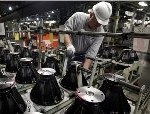 In the wake of Japan’s cascading disasters, signs of economic loss can be found in many corners of the globe, from Sendai, on the battered Japanese coast, to Paris to Marion, Ark.
In the wake of Japan’s cascading disasters, signs of economic loss can be found in many corners of the globe, from Sendai, on the battered Japanese coast, to Paris to Marion, Ark.
Container ships sit in the Pacific or at docks in Japan, wary of unloading tons of pork and steak because of that nation’s fractured electric grid. Any break in the “cold chain” of refrigeration can spoil meat.
LVMH Moët Hennessy Louis Vuitton, the luxury goods maker based in Paris, shut more than 50 of its stores in Tokyo and northern Japan. And Volvo, the Swedish carmaker, was working with a 10-day supply left of Japanese-built navigation and climate control systems.
“It’s hour-by-hour work to get a grip on the situation,” said Per-Ake Froberg, chief spokesman for Volvo, as it girds for a production halt.
The uncertain economic picture has mirrored the churning developments in Japan as it tries to recover from the devastating earthquake and tsunami that struck it 10 days ago. On Sunday, even as workers made some progress in stabilizing the situation at the crippled Fukushima Daiichi nuclear plant, the government said there were new signs of radioactive contamination in some agricultural produce and livestock.
Uncertainty hangs like a cloud over the future of the global and American economy. Only weeks ago, many economists foresaw a quickening of the recovery. Now tsunamis, radioactive plumes, Middle East revolutions, a new round of the European debt crisis and a still weakened United States economy could derail a tenuous bounceback in the United States, Europe and Japan.
Some global ills, like the spike in oil and food prices, can be quantified. But a clearer picture depends on indicators yet to come, like the March unemployment numbers and trade numbers.
“The problem is not Japan alone – it’s that Japan reinforces all the negative repercussions and our own weak recovery,” said Stephen S. Roach, nonexecutive chairman of Morgan Stanley Asia and a professor at Yale. “It’s difficult to know the tipping point for the global economy, but there are difficult headwinds now.”
Only a few weeks ago, economic forecasters suggested first-quarter growth in the United States would exceed 4 percent, and similar estimates edged toward 5 percent for global growth. Those estimates now seem in danger of being outdated.
Morgan Stanley’s tracking estimate for the United States’ growth in the first quarter has slipped in the last month to 2.9 percent from 4.5 percent, and that was before the troubles in Japan. Goldman Sachs in a report Friday suggested that global uncertainty might shave a half point off American gross domestic product for 2011, which its economists view as a flesh wound rather than a dire blow.
But other economists point to the uncertainty created by Reactors No. 1, 2, 3, and 4 at the stricken power station in Japan and say it adds to a sense of global foreboding.
In Libya, American missiles are flying and the oil wells stand silent. Saudi troops have marched into Bahrain, across the Persian Gulf from Iran. In Europe, finance ministers warn that hundreds of banks still carry billions of dollars in bad loans.
A recent survey of prominent global economists by The International Economy magazine found that a majority view it as likely that some combination of Greece, Ireland and Portugal will default on debt and force bond investors to take heavy losses. Oil prices have risen nearly 11 percent this year. Japan already is the largest importer of liquefied natural gas, and as it searches for energy to replace a fractured nuclear grid, analysts expect these prices to rise as well.
Finally, there is the United States, an economic colossus burdened by a foreclosure crisis and the worst long-term unemployment situation in nearly a century. If Japanese companies and investors retrench, selling some Treasuries and investing fewer yen overseas, the pain here could grow.
Bernard Baumohl, chief global economist with The Economic Outlook Group, was until recently quite the economic bull. No more.
“The uprisings, the Persian Gulf, Japan: It’s very likely that the global economic impact will be larger than most people currently imagine,” Mr. Baumohl said. “Electricity and gasoline prices will stay high and consumers are nervous. Guess what, that’s not an atmosphere conducive to corporations wanting to hire workers.”
There are some more optimistic forecasts. A report by the World Bank to be released Monday predicts that growth in Japan and its East Asian neighbors would pick up in the second half of this year. The country’s past experience, the report said “suggests an accelerated reconstruction effort” that will limit the short-term impact.
Indeed, some disruptions, even in Japan, could prove of short duration. Nissan said on Sunday it would reopen five of six plants in Japan this week, and Toyota and Honda are also in various stages of resuming production. Analysts expect Japan to cobble together a workable energy grid in the next few weeks. That will allow dockworkers to unload those pallets of pork and steak, not to mention bags of corn and soybean.
Japan’s appetite for American meat is considerable. It consumes 30 percent of American pork exports. “American hog prices took a real fall here this week,” said David Miller, research director for the Iowa Farm Bureau Federation. “But supermarket shelves are pretty empty in Japan; we could see a surge in demand soon.”
The global economy remains an adaptive animal. But the speed and efficiency of this adaptation is easily overstated. Japanese electronics, auto adhesives, and silicon-production facility require highly skilled labor and cannot take root overnight in another southeast Asian nation.
Nor is the speed of the global economy, and its intricate interlacing, necessarily a comfort. General Motors last week announced that it would suspend product at its 923-employee factory in Shreveport, La., which manufactures Chevrolet Colorado and GMC Canyon models, because it has already run short of Japanese made parts.
The human face of this disaster presents its own challenge. Many European and American companies in Tokyo dealt last week with a double emergency: They tried to cobble together supply chains even as they evacuated native-born workers to southern Japan, and repatriated foreign workers to their homelands.
Volvo, the Swedish automaker, is the most reliant of the European car companies on Japanese parts – seven of its suppliers are based in the region ravaged by the earthquake and tsunami, including one on the cusp of the radiation zone. Volvo managers are trying to determine how many parts already were loaded on ships.
“We are preparing ourselves for a shortage,” Mr. Froberg added. “If we can’t build any cars, we can’t sell any cars.”
Travel now half way around the world, to Marion, Ark., a city of 8,900 just west of the Mississippi River. As officials in Japan try to stave off nuclear catastrophe, the fate of a 10-inch round gear might seem inconsequential. But the gear, manufactured in Japan and shipped to the Hino Motors Manufacturing plant in Marion, symbolizes the multitude of disruptions affecting supply chains.
The plant employs 335 workers, who assemble rear axles for the Tundra pick-up truck as well as rear suspension parts for the Tacoma pick-up and Sequoia S.U.V. The factory imports about 20 percent of its parts from Japan. Even its suppliers in the United States purchase parts from smaller suppliers based in Japan. Some of those are in Sendai, the northern Japan city that was badly battered.
Last Wednesday, workers of forklifts zipped down the aisles of the 361,000-square-foot factory, ferrying parts to the assembly lines. Stacks of bright blue plastic crates stood on pallets labeled “Made in Japan.” Each crate held a ten-inch round gear and steel pinion that form an essential part of the Tundra rear axles.
“We are monitoring everyday which suppliers actually have a problem,” said Shinichi Sato, treasurer and secretary of Hino’s United States operations.
The company typically gets a shipment of gears from Japan every other day. For now, shipments continue to arrive, because many crates are stacked up in warehouses in Long Beach, Calif., where the components are unloaded from Japan.
No one knows how long the boxes will keep coming. In Japan, the Hino plant is undergoing three-hour rolling blackouts. Its suppliers draw power from the now-disabled nuclear plants. And limited train service means many employees cannot get to work.
Managers in Marion talk about searching elsewhere for parts. But that’s not a long-term solution.
“Some parts are possible to get elsewhere, but our parts are very important parts,” noted Mr. Sato, who takes a quiet pride in the quality of the Japanese parts. “So it is not easy to ask other suppliers to produce them.”
{NY Times/Matzav.com Newscenter}











